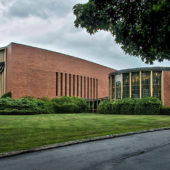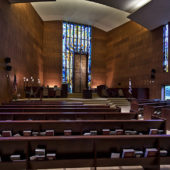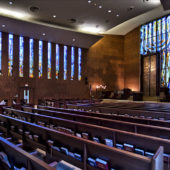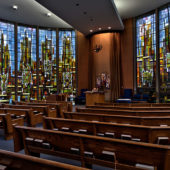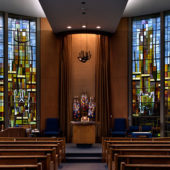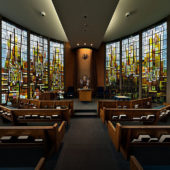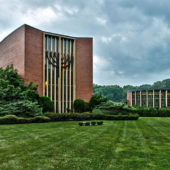Striking stained glass windows emphasize the building’s architectural form.
Congregation B’nai Jacob was founded in 1882 by Jewish immigrants from Russia. The congregation acquired its first permanent building in 1885. As it grew in membership through the 1890s and early 1900s the synagogue constructed an impressive building in the Moorish architectural style situated on Woodbridge’s George Street.
In 1957 land was acquired at the present Rimmon Road site. Fritz Nathan, a prominent architect was engaged to design the building. A particularly prominent and fine feature of the building are the stained glass windows designed by Jean-Jacques Duval. In fact, Both Congregation Mishkan Israel in Hamden and Congregation B’nai Jacob in Woodbridge were designed by Fritz Nathan and Bertram Bassuk (1918-1996), and both include chapels with stained glass by Duval, and Duval did the sanctuary work at B’nai Jacob, too.
In the words of noted Jewish Art Historian Samuel Gruber, “Duval’s greatest success, however, in both chapels, was his ability to create full walls of stained glass that actually helped emphasize and strengthen the shape of the space instead of distracting from it. Duval has demonstrated this talent for making architectural walls that complemented the architecture design in many synagogue and church commissions. Most of his stained glass windows are not to be seen through, or even to be looked at as pictures. Rather, they enclose the viewer to create a container of worship space.”
Jean-Jacques Duval was born in Strasbourg, France. After World War II he studied at Ecoles des Arts Decoratif of Strasbourg. In 1950 Duval came to the United States to design for a major stained glass studio. By 1957 he opened his own studio in New York City. As of this writing in 2013, Duval continues his artistic career from his studio in Saranac, New York. He has more than 450 major commissions to his credit.

